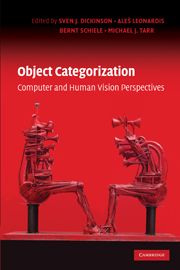Book contents
- Frontmatter
- Contents
- Preface
- Contributors
- 1 The Evolution of Object Categorization and the Challenge of Image Abstraction
- 2 A Strategy for Understanding How the Brain Accomplishes Object Recognition
- 3 Visual Recognition Circa 2008
- 4 On What It Means to See, and WhatWe Can Do About It
- 5 Generic Object Recognition by Inference of 3-D Volumetric Parts
- 6 What Has fMRI Taught Us About Object Recognition?
- 7 Object Recognition Through Reasoning About Functionality: A Survey of Related Work
- 8 The Interface Theory of Perception: Natural Selection Drives True Perception to Swift Extinction
- 9 Words and Pictures: Categories, Modifiers, Depiction, and Iconography
- 10 Structural Representation of Object Shape in the Brain
- 11 Learning Hierarchical Compositional Representations of Object Structure
- 12 Object Categorization in Man, Monkey, and Machine: Some Answers and Some Open Questions
- 13 Learning Compositional Models for Object Categories from Small Sample Sets
- 14 The Neurophysiology and Computational Mechanisms of Object Representation
- 15 From Classification to Full Object Interpretation
- 16 Visual Object Discovery
- 17 Towards Integration of Different Paradigms in Modeling, Representation, and Learning of Visual Categories
- 18 Acquisition and Disruption of Category Specificity in the Ventral Visual Stream: The Case of Late Developing and Vulnerable Face-Related Cortex
- 19 Using Simple Features and Relations
- 20 The Proactive Brain: Using Memory-Based Predictions in Visual Recognition
- 21 Spatial Pyramid Matching
- 22 Visual Learning for Optimal Decisions in the Human Brain
- 23 Shapes and Shock Graphs: From Segmented Shapes to Shapes Embedded in Images
- 24 Neural Encoding of Scene Statistics for Surface and Object Inference
- 25 Medial Models for Vision
- 26 Multimodal Categorization
- 27 Comparing 2-D Images of 3-D Objects
- Index
- Plate section
1 - The Evolution of Object Categorization and the Challenge of Image Abstraction
Published online by Cambridge University Press: 20 May 2010
- Frontmatter
- Contents
- Preface
- Contributors
- 1 The Evolution of Object Categorization and the Challenge of Image Abstraction
- 2 A Strategy for Understanding How the Brain Accomplishes Object Recognition
- 3 Visual Recognition Circa 2008
- 4 On What It Means to See, and WhatWe Can Do About It
- 5 Generic Object Recognition by Inference of 3-D Volumetric Parts
- 6 What Has fMRI Taught Us About Object Recognition?
- 7 Object Recognition Through Reasoning About Functionality: A Survey of Related Work
- 8 The Interface Theory of Perception: Natural Selection Drives True Perception to Swift Extinction
- 9 Words and Pictures: Categories, Modifiers, Depiction, and Iconography
- 10 Structural Representation of Object Shape in the Brain
- 11 Learning Hierarchical Compositional Representations of Object Structure
- 12 Object Categorization in Man, Monkey, and Machine: Some Answers and Some Open Questions
- 13 Learning Compositional Models for Object Categories from Small Sample Sets
- 14 The Neurophysiology and Computational Mechanisms of Object Representation
- 15 From Classification to Full Object Interpretation
- 16 Visual Object Discovery
- 17 Towards Integration of Different Paradigms in Modeling, Representation, and Learning of Visual Categories
- 18 Acquisition and Disruption of Category Specificity in the Ventral Visual Stream: The Case of Late Developing and Vulnerable Face-Related Cortex
- 19 Using Simple Features and Relations
- 20 The Proactive Brain: Using Memory-Based Predictions in Visual Recognition
- 21 Spatial Pyramid Matching
- 22 Visual Learning for Optimal Decisions in the Human Brain
- 23 Shapes and Shock Graphs: From Segmented Shapes to Shapes Embedded in Images
- 24 Neural Encoding of Scene Statistics for Surface and Object Inference
- 25 Medial Models for Vision
- 26 Multimodal Categorization
- 27 Comparing 2-D Images of 3-D Objects
- Index
- Plate section
Summary
Introduction
In 2004, I was a guest at the Center for Machine Perception at the Czech Technical University. During my visit, a graduate student was kind enough to show me around Prague, including a visit to the Museum of Modern and Contemporary Art (Veletrzní Palác). It was there that I saw the sculpture by Karel Nepras entitled “Great Dialogue,” a photograph of which appears in Figure 1.1. The instant I laid eyes on the sculpture, I recognized it as two humanoid figures seated and facing each other; when I've presented a 2-D image (Fig. 1.1) of the sculpture to classroom students and seminar audiences, their recognition of the two figures was equally fast. What's remarkable is that at the level of local features (whether local 2-D appearance or local 3-D structure), there's little, if any, resemblance to the features constituting real 3-D humans or their 2-D projections. Clearly, the local features, in terms of their specific appearance or configuration, are irrelevant, for individually they bear no causal relation to humans. Only when such local features are grouped, and then abstracted, do the salient parts and configuration begin to emerge, facilitating the recognition of a previously unseen exemplar object (in this case, a very distorted statue of a human) from a known category (humans).
Information
- Type
- Chapter
- Information
- Object CategorizationComputer and Human Vision Perspectives, pp. 1 - 37Publisher: Cambridge University PressPrint publication year: 2009
Accessibility standard: Unknown
Why this information is here
This section outlines the accessibility features of this content - including support for screen readers, full keyboard navigation and high-contrast display options. This may not be relevant for you.Accessibility Information
- 22
- Cited by
